QIA
以及技能为导向的学习
剑桥1~2
1、通过情境学习词汇。
2、通过chant 学习词汇
3、语言知识
4、通过歌曲巩固和复现词汇
5、通过情境学习语音
6、故事教学:复现语言知识点,探索学习其他内容。
7、CLIL教学
8、Values

9. Revie Unit
听说读到写得引入
剑桥3~4
词汇在听力中学习(Vocabulary Listening)
词汇在语法教学和阅读中学弟Vocabulary & Grammar Reading
听说读写全面发展
1、听力input 词汇学习输入
2、歌曲input Vocabulary & Grammar巩固复现,通过ask and answer 来复习
3、语法点:通过listening and speaking
input and intake (词汇、语法的输入和内化)
4、通过读、听、写进行语法练习(Grammar: Reading&Listening, Speaking& Writing)
5、语音教学(Pronunciation:Listening&Speaking;Interaction:Speaking)--output
6、故事教学 Lock&Key 巩固词汇和语法,为下一次的教学做铺垫
7、CLIL教学 (Reading泛读学语言知识)
剑桥5~6
1、听力技能
2、语法学习和练习
听力中来学习语法,通过一些活动
3、语篇(Reading skills---reading for gisy大意),在阅读中学习词汇,培养阅读技能。
4、阅读练习
(通过阅读来培养技能)
5、语音(Phonics for enhance spelling awareness; From oral skills to writing skills,buiding up senctences and paragraphs.)
6、故事教学,趣味阅读,培养阅读兴趣。
7、CLIL教学 大量的泛读(Teaching objectives: Ultimate goal of learning language---Using the language)
主题和词汇的循环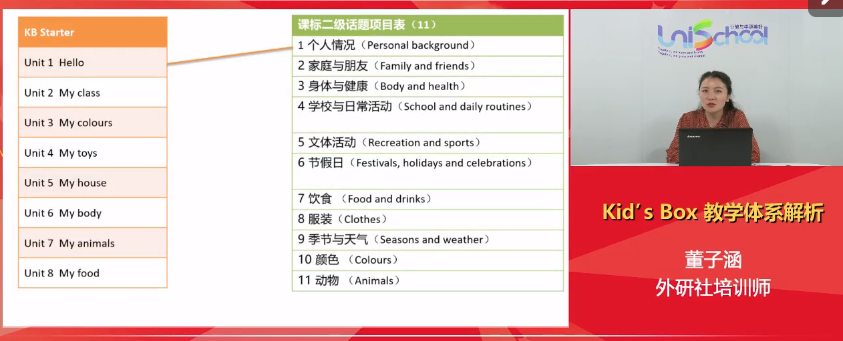

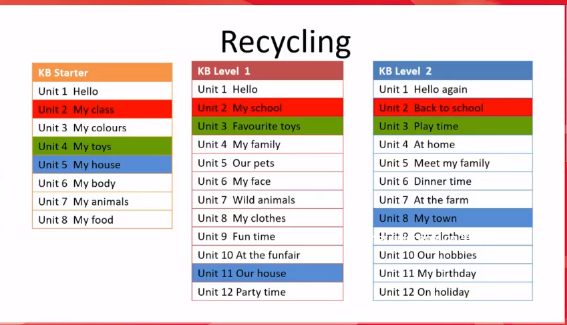
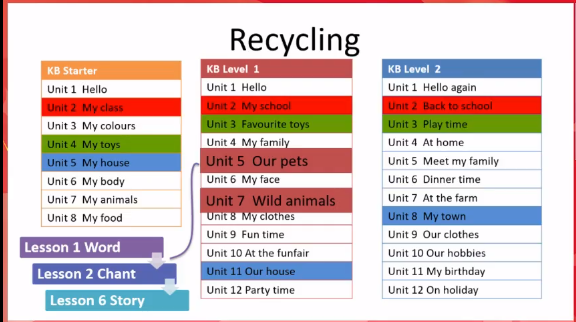
语法和功能复现
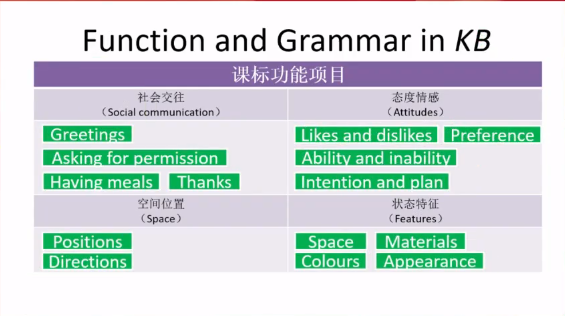
What's CLIL?
Content and Language Integrated Learning (CLIL)
Using English to Learn
Learning to use English
Match the aims with the descriptions.
Aims:
Subject: Develop thinking skills from the start.
Language; Learn to use English (Academic English)
Cognition
Culture:
Use English to learn (Academic knowledge)
Learners with different home languages as well as different social and cultural backgrounds sometimes need to communicate in a non-native language.
Evaluation
We focous on what children can do, rather than what they can't do.
营造一个轻松,有效的环境来学习。
I hear and I forget. I see and I remember. I do and I understand.
学完达到ket水平
情景中学习 不断复现
词汇 listenging speaking input and intake output
clil教学 using the language
泛读来学习语言知识
5/6册 语篇中
CLIL教学法在kids box 中的体现
bringing values into the classroom
fostering positic values in story
学生能做什么。而不是不能做什么
Who can you see? I can see....
listen 1 just listen
2 listen and repeat
3
Greetings:
Warm up: song
Presentationg: Train and guess; go to the zoo and find the target animals; 人物引入 guess which animals they visit one by one.
Practice: 不同方式引入动物句子 What have they got. (visit the zoo / read sentences and guess animal 'snake')
1. "What have they got?" Show pics and guess. Discuss and show the answer. Listen and repeat.
2. spin the spinner. (Students ask and answer to guess animals )
电子版&手工版 spinner 小组练习
3. chant
Production:
Pic show and ask sentences "Which animal do you like? What have they got? Why do you like them? "
Crazy zoo: snigers .
How can we write crazy aniamls? 写作
(brain storm 展开句子;给出example words and structures , 学生写)
1 Warm up (which animal do you like )(3min)
2 presentation
PPT guessing game -introduce animal
new words :leg hand arm feet tail foot teeth mouth
For example: picture- monkey
What have they got?
They have got _______and_________.
crocodiles>>>>>>
elephants>>>>>>
snakes>>>>>>>
3 practice :Spin the spinner game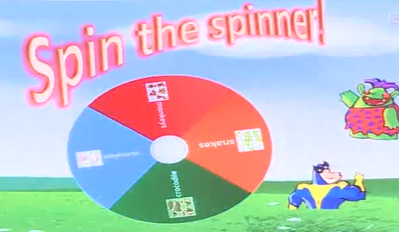
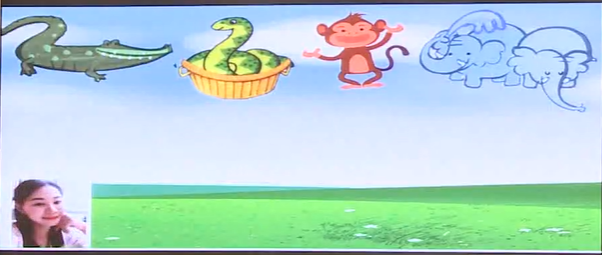
which anmal do you like?
What have they got?
Why do you like them?
1.Warm up : Zoo animals song
elephant kangaroo penguin giraffe rhino ...
2.Lead in:What are in the boxes on the train?
Guess.
Listen and answer: monkeys crocodiles snakes elephants
Match :Animals and habitats
3.Presentation:
Situation: Monty Trevor and Maskman are visiting the zoo:
1.Monkeys:What have they got?-They have got long arms/hands/legs(phonics-l-e-g)/tail(phonics-t-ai-l)/foot/feet(oo-ee).
Students listen and say: What have they got?-They have got ...
2.crocodiles:Group talking-What have they got?-They have got ...
Listen and say:They've got big mouths and long tails/a lot of teeth/short legs and short feet.
How many teeth have ...got?-Two teeth./A lot of teeth.
3.Elephants:What have they got?-They've got long noses/big ears/short tails.
4.Riddle-They've got ... They haven't got ...-Snakes
4.Practice:Spin the spinner Game: You say,I guess
5.Production:Which animals do you like and why? What have they got?
-I like ... because they're .. They've got ...
6.Create: Crazy animals
They're... They've got ... They can ...
Name ; colour ;size ; body parts; ability
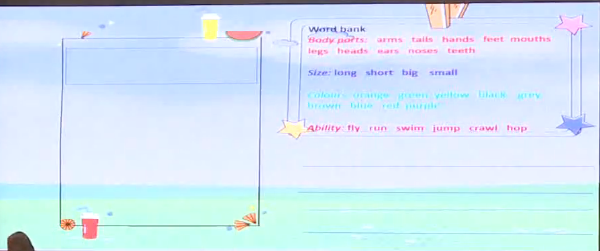
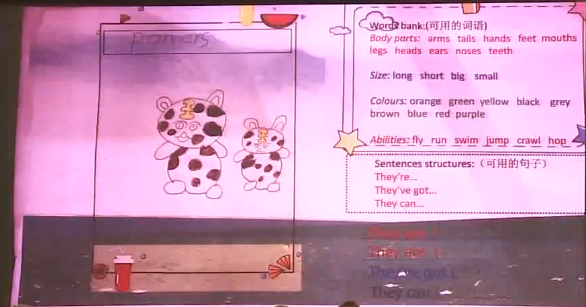
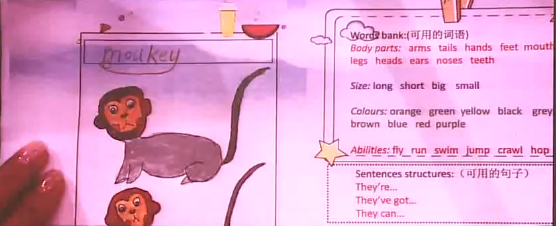
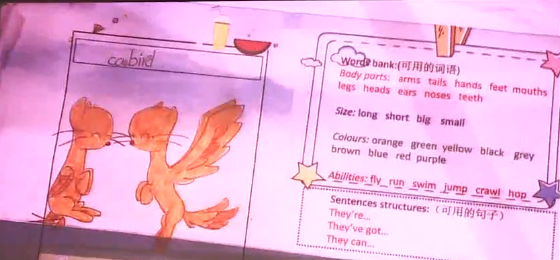
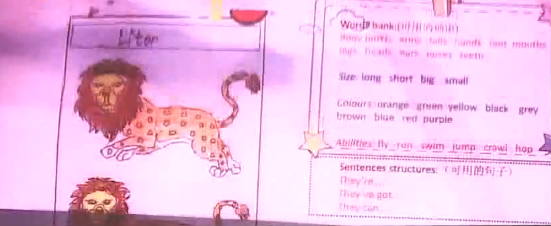
Lead in: Guessing game——
Presetation:
1 Warm up head shouders (3min)
2 presentation
guessing game -introduce body parts
5new words (single plural)
3 practice
flashcard PPT 正反面
listening
a recognizing the new words (shouting out new words) PPT
b They hace got_______.
They haven't________.
c Checking :filling out the words
Greetings:
Warm up: song 'Head shoulders kness and toes.
Presentation: Guessing game (introduce body parts words : singular and plural)
Practice:
1.Listening : recognizing new words
(listen and follow)
2. Flashing cards to practice.
(pictures reading and words reading)
3. filling in the blanks.
4. Introduce sentences :
They have got________
They haven't got_________
(Show the pics with the structures and let students say the missing words. )
5. Listen to the text.
6.Filling the words and text.
Warm up
<Head shoulder knees and toes>
Warm up: head should knees and toes. 3mins
presentation:
Guessing Game----introduce body parts
five new words(singular/plural)
Practice:
flashcards: PPT(正反)
Listening:
1. recognizing the new words(shouting out new words)(PPT)
2. They have got ______.
They haven't got ________.
3.Checking: filling out words_______scripts:
4. filling out sentences.__________.(singular/plural)
一般疑问句学习Are those....?
Yes, they are. / No, they aren't.
1、先引导学生观看图片。
2、教授物品单词。
3、听录音并且复述。
1、引导学生认真观看图片并领会故事的大概意思。
2、教师进行引导跟讲解。
3、听录音、模仿。
1、先学习游乐场里面的东西名称再来描述他们分别在做什么?
2、重点句型:What are they doing?
They are ....
3、再进行听力操练及复述。


